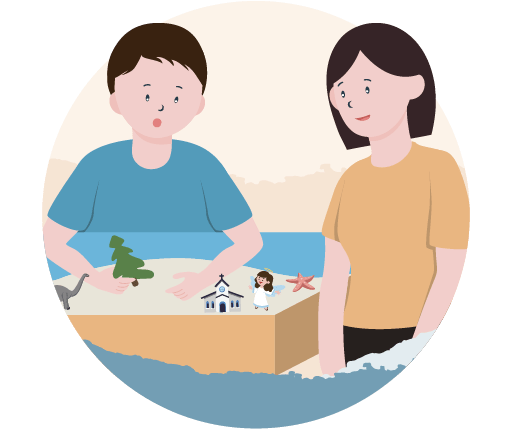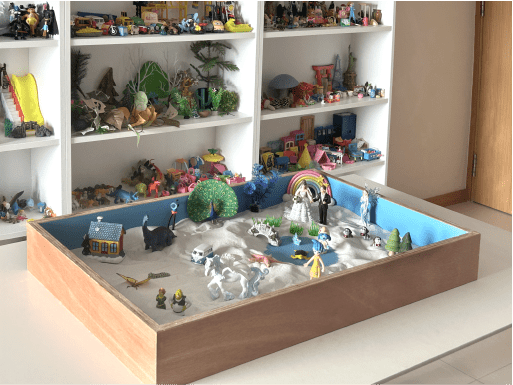Overview
When To Seek Help
Therapeutic Modalities
Overview
Sandplay Therapy is a Non-Verbal, Expressive, Sensory-Based therapeutic intervention that facilitates the mind’s natural capacity for Healing. It uses a Sand Tray and Miniature Figurines to help individuals express Emotions, Process Trauma, and work through their Psychological Issues.
Sandplay Therapy is based on the idea that the Unconscious Mind can be assessed and explored through Symbolic Play, and it is particularly useful for Individuals (Adult, Adolescent, or Child) who find it difficult to articulate their Feelings with Words, Trauma Survivors, or Individuals with Severe Emotional Distress.
Sandplay Therapy is based on the idea that the Unconscious Mind can be assessed and explored through Symbolic Play, and it is particularly useful for Individuals (Adult, Adolescent, or Child) who find it difficult to articulate their Feelings with Words, Trauma Survivors, or Individuals with Severe Emotional Distress.
History of Sandplay
Paediatrician and Child Psychiatrist Margaret Lowenfeld (1890-1973), first developed the therapeutic use of the Sandtray and Miniatures in the 1920s. She had read H.G. Wells’ books Floor Games (1911), in which Wells talks about his elaborate playing with Miniature Toys on the floor with his two sons. Lowenfeld adapted this concept in her Counselling Institute, using Metal Trays with Sand and Water, and Miniatures Toys in Boxes. She would ask her Child Clients to combine the materials to create “World Pictures.” This technique was later called the “Lowenfeld World Technique” (Lowenfeld, 1979).
Swiss Jungian Psychologist Dora Kalff (1904-1990) and student of Lowenfeld, developed in the late fifties the therapeutic method called “Sandplay Therapy”. It is based on the Depth Psychology by Carl Gustav Jung (1875-1961) and on the “World Technique” originated by Margaret Lowenfeld. Dora Kalff’s intensive interest and studies of Eastern philosophy, in particular Zen Buddhism, Tibetan Buddhism, and Taoism contributed to a deepening of vision and understanding of both the creations in Sand as well as the Therapeutic Attitude of the Therapist.
As one of Carl Gustav Jung’s (1875-1961) student, Dora Kalff's Sandplay intervention is deeply rooted in her training in Jungian Psychology, which focuses on forming a Harmonious Balance between the Conscious and Unconscious. According to Carl Jung, the Symbol is the Language of the Psyche. Dora Kalff called the Sandtray "A Free and Protected Space” for the Non-Verbal and Symbolic Expression of the client’s Inner World. She refers to Sandplay Therapy as part of the Self-Regulating capacities of the Psyche.
Sandplay Therapy facilitates the Connection of the Conscious with the Unconscious Mind and Heart to uncover Deeply Rooted Feelings and Beliefs, which affect present Thoughts, Feelings, and Behaviours. It focuses on the person's wellbeing beyond the symptoms of the problems or concerns presented, leading to the Natural Healing Process. Sandplay Therapy is helpful for assessing and treating a variety of Mental Health challenges and Psychological Trauma.
Sandtray Therapy is used in a therapeutic setting, and this process uses Sand and Miniature Figurines in a Directive manner from the Therapist. Sandtray Therapy is Interpersonal in nature and allows either One or More Persons (Adults, Adolescents, or Children) to work on the Sand Tray.
Sandplay Therapy takes place in a Rectangular Box referred to as Sand Tray. The Sand Tray is filled with Sand that Clients use, along with Miniature Figurines, and sometimes Water, to create Scenes of a Miniature Play World that reflects some aspect of a Person’s Inner Thoughts, Feelings, Experiences, Struggles, and Preoccupations in their Own Lives. The Therapist observes the Choice and Arrangement of these Miniature Figurines without interruption, allowing the Person to Heal and find answers within themselves.
Awareness of Self
The Sandplay process of a Safe and Protected Space from the Sand Tray Rectangular Box facilitates Healing and Transformation. This is done by Uncovering Conflicts, Deeply Rooted Feelings and Beliefs from the Unconscious Mind, which subsequently affects present Thoughts, Emotions, and Behaviours.
Sandplay Therapy is a Non-Verbal and Symbolic form of therapy, and is less confrontational for those who are hesitant to engage in “Talk Therapy”. It appeals to Adult of all ages, Adolescent, and Children who may struggle to express Complex Emotions verbally. Therefore, they can explore their Emotions in a Safe, Creative, and Non-Threatening way.
Sensory and Experiential
Sandplay Therapy can also provide a Sensory Experience through Touching and Manipulation of the Sand, and this supports Positive Self-Regulation, Reduce Stress-Related Reactions and Develop Self-Soothing Behaviours.
Mind-Body-Spirit Connection
Sandplay Therapy aligns with Mindfulness Practices to focus on your Intrapsychic Self to Heal and integrates with the Mind-Body-Spirit Connection.
Grief, Trauma, and other Holistic Healing
Sandplay Therapy allows for expressing Trauma Symbolically, especially for those who cannot Process or Recognise their Trauma, and this stems from Childhood Trauma, Grief, Loss, or Abuse. It also allows Adult or Survivors of Trauma a Safe Space to explore their Inner World without having to directly recount Traumatic Experiences. This is done through Indirect Symbolic Representation of Trauma through the use of Miniatures and Sand. Hence, this feels less Emotionally intense than talking directly about their Grief, Trauma, or Painful Memories and Experiences.
Integrative with other Counselling Therapies
Sandplay Therapy can be integrated with other “Talk Therapy” approaches to benefit clients holistically in their Healing, e.g. Couple Therapy. Sandplay Therapy is suitable for Adult of all ages, Adolescent, and Child aged 6 years old and above.
As one of Carl Gustav Jung’s (1875-1961) student, Dora Kalff's Sandplay intervention is deeply rooted in her training in Jungian Psychology, which focuses on forming a Harmonious Balance between the Conscious and Unconscious. According to Carl Jung, the Symbol is the Language of the Psyche. Dora Kalff called the Sandtray "A Free and Protected Space” for the Non-Verbal and Symbolic Expression of the client’s Inner World. She refers to Sandplay Therapy as part of the Self-Regulating capacities of the Psyche.
Sandplay Therapy facilitates the Connection of the Conscious with the Unconscious Mind and Heart to uncover Deeply Rooted Feelings and Beliefs, which affect present Thoughts, Feelings, and Behaviours. It focuses on the person's wellbeing beyond the symptoms of the problems or concerns presented, leading to the Natural Healing Process. Sandplay Therapy is helpful for assessing and treating a variety of Mental Health challenges and Psychological Trauma.
Differences Between Sandplay Therapy and Sandtray Therapy
Sandplay Therapy is an Undirected process employing the therapeutic benefits of Free Play, allowing Unconscious material to emerge and Heal as and when it is ready to be explored, which takes place over a series of Sandplay process. Sandplay Therapy is Intrapsychic in nature and allows only One Person (Individual Adult, Adolescent, or Child) to work on the Sand Tray.Sandtray Therapy is used in a therapeutic setting, and this process uses Sand and Miniature Figurines in a Directive manner from the Therapist. Sandtray Therapy is Interpersonal in nature and allows either One or More Persons (Adults, Adolescents, or Children) to work on the Sand Tray.
What to Expect from Sandplay Therapy
ProcessSandplay Therapy takes place in a Rectangular Box referred to as Sand Tray. The Sand Tray is filled with Sand that Clients use, along with Miniature Figurines, and sometimes Water, to create Scenes of a Miniature Play World that reflects some aspect of a Person’s Inner Thoughts, Feelings, Experiences, Struggles, and Preoccupations in their Own Lives. The Therapist observes the Choice and Arrangement of these Miniature Figurines without interruption, allowing the Person to Heal and find answers within themselves.
Awareness of Self
The Sandplay process of a Safe and Protected Space from the Sand Tray Rectangular Box facilitates Healing and Transformation. This is done by Uncovering Conflicts, Deeply Rooted Feelings and Beliefs from the Unconscious Mind, which subsequently affects present Thoughts, Emotions, and Behaviours.
Effectiveness of Sandplay Therapy
Non-VerbalSandplay Therapy is a Non-Verbal and Symbolic form of therapy, and is less confrontational for those who are hesitant to engage in “Talk Therapy”. It appeals to Adult of all ages, Adolescent, and Children who may struggle to express Complex Emotions verbally. Therefore, they can explore their Emotions in a Safe, Creative, and Non-Threatening way.
Sensory and Experiential
Sandplay Therapy can also provide a Sensory Experience through Touching and Manipulation of the Sand, and this supports Positive Self-Regulation, Reduce Stress-Related Reactions and Develop Self-Soothing Behaviours.
Mind-Body-Spirit Connection
Sandplay Therapy aligns with Mindfulness Practices to focus on your Intrapsychic Self to Heal and integrates with the Mind-Body-Spirit Connection.
Grief, Trauma, and other Holistic Healing
Sandplay Therapy allows for expressing Trauma Symbolically, especially for those who cannot Process or Recognise their Trauma, and this stems from Childhood Trauma, Grief, Loss, or Abuse. It also allows Adult or Survivors of Trauma a Safe Space to explore their Inner World without having to directly recount Traumatic Experiences. This is done through Indirect Symbolic Representation of Trauma through the use of Miniatures and Sand. Hence, this feels less Emotionally intense than talking directly about their Grief, Trauma, or Painful Memories and Experiences.
Integrative with other Counselling Therapies
Sandplay Therapy can be integrated with other “Talk Therapy” approaches to benefit clients holistically in their Healing, e.g. Couple Therapy. Sandplay Therapy is suitable for Adult of all ages, Adolescent, and Child aged 6 years old and above.

When To Seek Help
You may seek help through Sandplay Therapy when Emotional Struggles persist despite Traditional Talk Therapy, when there is difficulty in Verbalizing Emotions, or when there is a History of Trauma. Individual Adult, Adolescent, or Child dealing with Unresolved Trauma and Grief, Deep Emotional Distress, or Interpersonal Challenges may turn to Sandplay Therapy as a way to better Heal and Express their Emotions in a Safe and Non-Threatening environment.You may benefit from Sandplay Therapy (for Individual Adult, Adolescent, or Child) when you have:
Difficulty Verbalising Feelings
Sandplay Therapy offers a Non-Verbal way for Individual Adult, Adolescent, or Child, to express their Emotions when Verbal Expression is challenging.
Difficulty Managing Emotions
Individual Adult, Adolescent, or Child may Struggle to Regulate their Emotions and this leads to having Negative Behaviours like Shouting and Physical Violence.
Struggling with Anxiety, Depression, or other Emotions
Feeling Overwhelmed by Persistent Worries, Sadness, or other Emotions. Sandplay Therapy provides a Creative and Experiential way to Explore Internal Struggles and bring forth Unconscious Issues to Self-Awareness.
Unresolved Past Hurts and Trauma
Sandplay Therapy helps Individual Adult, Adolescent, and Child express Complex Emotions and Childhood or Adulthood Past Traumatic Incident that are hard to articulate verbally.
Grief and Loss
Sandplay Therapy allows Individual Adult, Adolescent, and Child to work and process their Grief and Loss in a Safe and Supportive Space.
Struggling with Self-Esteem or Self-Confidence
This is applicable to Individual Adult, Adolescent, and Child feeling Unsure of Oneself or Lacking Confidence in their Social Life.
Feeling Stuck or Lacking Direction
Unsure about Life Goals or Direction to Studies, Career, or Relationships.
Feeling Stress and Unable To Cope in Life
Emotional Regulation during Sandplay Therapy helps Clients Identify Stressors and Cope Better in their Lives.
Dealing with Relationship Difficulties
Struggling with Challenges in Personal Relationships.
Child's Behavioural Issues at Home or in School
Having Negative Behaviours, e.g. Fighting, Bullying, Stealing, or others in any Social Setting that affects the Child's School Performance and their Relationships with their Family and Friends.
Facing Individual and Family Life Stage Transition or Making Major Decisions
Feeling Unsure or Stressed about Major Changes or Decisions to Individual and Family Life Stage Transition, e.g. having Difficulty adjusting to events like Grief, Divorce, Relocation, or any other Family Changes.

Therapeutic Modalities
Sandplay Therapy can be used on its own or Integrates with other Therapeutic Approaches to Support Healing and Self-Discovery.
These may include:
Sandplay Therapy
Sandtray Therapy
Expressive Arts Therapy using Symbol Work
Expressive Arts Therapy for Enhancing Couple and Family Connections
Child-Centred Play Therapy
Mindfulness Therapy
Solution Focused Brief Therapy
Trauma Focused Therapy
Grief Therapy
These may include:
Sandplay Therapy
Sandtray Therapy
Expressive Arts Therapy using Symbol Work
Expressive Arts Therapy for Enhancing Couple and Family Connections
Child-Centred Play Therapy
Mindfulness Therapy
Solution Focused Brief Therapy
Trauma Focused Therapy
Grief Therapy
